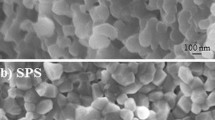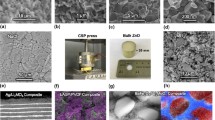Abstract
It has been reported that the master sintering curve (MSC), in which the sintered density is a unique function of the integral of a temperature function over time, is insensitive to the heating path. The present research was undertaken to determine whether the MSC concept is applicable to hot pressing, and to develop the pressure-assisted master sintering surface for alumina. Densification of Sumitomo AKP30 alumina was continuously recorded during heating at 10°C/min at fixed pressures from 7 to 34.5 MPa. Final densities computed from the dilatometer traces were in excellent agreement with values determined by the Archimedes method. The thermocouple was calibrated using the melting point of the Ni/C eutectic. An accuracy of ±2°C was established. The pressure-assisted master sintering surface was successfully constructed. Using this surface, the final density can be predicted to about 1% accuracy for a fixed pressure and an arbitrary temperature-time path.
Similar content being viewed by others
References
T. VASILOS and R. M. SPRIGGS, J. Amer. Ceram. Soc. 46 (1963) 493.
P. H. CRAYTON and J. J. PRICE, Ceramic Bulletin 63 (1984) 715.
G. J. LESHKIVICH and P. H. CRAYTON, Am. Ceram. Soc. Bull. 64 (1985) 684.
M. N. RAHAMAN, F. L. RILEY and R. J. BROOK, J. Amer. Ceram. Soc. 63 (1980) 648.
M. N. RAHAMAN, L. C. DE JONGHE and R. J. BROOK, ibid. 69 (1986) 53.
D. LYNN JOHNSON, Scripta Met. 3 (1969) 567.
R. L. COBLE and J. S. ELLIS, J. Amer. Ceram. Soc. 46 (1963) 438.
G. E. GAZZA, “Engineering Metal Handbook, Ceramics and Glasses, ” Vol. 4 (ASM International, Metal Park, OH, 1991) p. 296.
R. L. COBLE, J. Appl. Phys. 41 (1970) 4798.
M. R. NOTIS and P. WINGERT, Science of Sintering 10 (1978) 35–44.
H. S. KIM and D. N. LEE, Mater. Sci. Eng. A-Struct. Mater. 271 (1999) 424.
P. MURRAY, D. T. LIVEY and J. WILLIAMS, “Ceramic Fabrication Processes, ” edited by W. D. Kingery (Technology Press of Massachusetts Institute of Technology and John Wiley & Sons, NY, 1958) p. 147.
J. D. Mcclelland, J. Amer. Ceram. Soc. 44 (1961) 526.
R. M. SPRIGGS and T. VASILOS, ibid. 47 (1964) 47.
R. C. ROSSI and R. M. FULRATH, ibid. 48 (1965) 558.
P. L. FARNSWORTH and R. L. COBLE, ibid. 49 (1966) 264.
L. T. KUHN, R. M. Mcmeeking and F. F. LANGE, ibid. 74 (1991) 682.
H. SU and D. L. JOHNSON, ibid. 79 (1996) 3211.
J. D. HANSEN, R. P. RUSIN, M. TENG and D. L. JOHNSON, ibid. 75 (1992) 1129.
D. L. JOHNSON, R. P. RUSIN and J. D. HANSEN, in “Sintering-Advances in Powder Metallurgy and Particulate Materials, ” Vol. 3 (Metal Powder Industries Foundation, Princeton, NJ, 1992) p. 17.
E. A. BRANDES, in “Metals Reference Book, ” 6th ed. (Butterworth, London, 1983) p. 11.
H. J. FROST and M. F. ASHBY, “Deformation-Mechanism Maps: The Plasticity and Creep of Metals and Ceramics” (Pergamnon Press, Oxford, 1982).
Author information
Authors and Affiliations
Corresponding author
Rights and permissions
About this article
Cite this article
An, K., Johnson, D.L. The pressure-assisted master sintering surface. Journal of Materials Science 37, 4555–4559 (2002). https://doi.org/10.1023/A:1020627811776
Issue Date:
DOI: https://doi.org/10.1023/A:1020627811776




